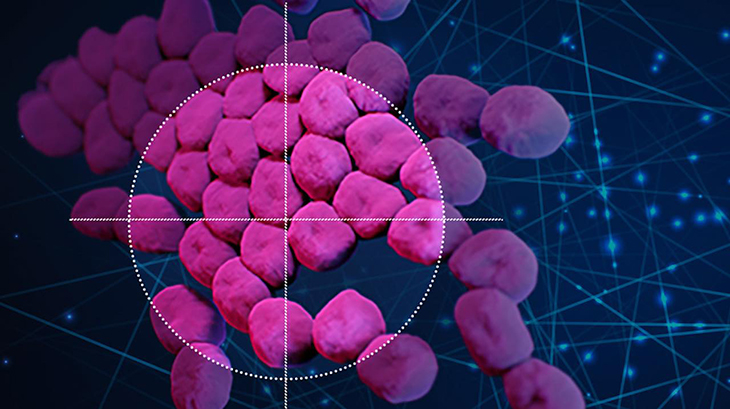
In a groundbreaking advancement, MIT researchers have harnessed the power of deep learning, a form of artificial intelligence, to uncover a novel class of compounds capable of combatting a drug-resistant bacterium responsible for over 10,000 deaths annually in the United States.
Published in Nature this week, the study showcases the efficacy of these compounds in eradicating methicillin-resistant Staphylococcus aureus (MRSA) both in laboratory settings and in two distinct mouse models of MRSA infection.
MIT’s Institute for Medical Engineering and Science (IMES) and Department of Biological Engineering, James Collins, says, “Our work provides a framework that is time-efficient, resource-efficient, and mechanistically insightful, from a chemical-structure standpoint, in ways that we haven’t had to date.”
Notably, these compounds exhibit minimal toxicity towards human cells, positioning them as promising candidates for drug development.
One of the study’s pivotal contributions lies in its innovative approach, which holds the potential to inform the design of even more effective drugs in the future. By leveraging deep learning, the researchers have embarked on a quest to discover new antibiotics, a journey that has already yielded promising leads against various drug-resistant bacteria, including Acinetobacter baumannii.
Although these deep learning models have proven successful in sifting through vast libraries of compounds to identify potential antimicrobial agents, they operate as “black boxes,” offering little insight into the underlying basis of their predictions.
As per postdoc at IMES and the Broad Institute of MIT and Harvard and one of the lead authors of the study, Felix Wong, “What we set out to do in this study was to open the black box. These models consist of very large numbers of calculations that mimic neural connections, and no one really knows what’s going on underneath the hood.”
The training data for the deep learning model was generated by testing approximately 39,000 compounds for their antibiotic activity against MRSA. Subsequently, this data, along with details regarding the chemical structures of the compounds, was inputted into the model.
“You can represent basically any molecule as a chemical structure, and also you tell the model if that chemical structure is antibacterial or not. The model is trained on many examples like this. If you then give it any new molecule, a new arrangement of atoms and bonds, it can tell you a probability that that compound is predicted to be antibacterial,” says Dr. Wong.
To address this limitation, the researchers employed an adapted version of the Monte Carlo tree search algorithm, enabling the model not only to predict antimicrobial activity but also to pinpoint the molecular substructures likely responsible for such activity.
Compelling Activity
To further refine their selection process, the researchers trained additional deep learning models to assess the toxicity of compounds against different types of human cells. By integrating this data with predictions of antimicrobial activity, they identified compounds capable of eliminating microbes while posing minimal harm to human cells.
This multi-model approach facilitated the screening of approximately 12 million commercially available compounds, resulting in the identification of promising candidates from five distinct chemical classes. Subsequent experiments confirmed the efficacy of two compounds, belonging to the same class, in significantly reducing MRSA populations in both lab dish and mouse models.
The researchers acquired approximately 280 compounds and subjected them to testing against MRSA cultured in a laboratory environment. This process enabled them to pinpoint two compounds belonging to the same class, showing considerable promise as antibiotic candidates. Upon conducting trials in wo mouse models – one simulating MRSA skin infection and the other MRSA systemic infection – it was found that each of these compounds resulted in a tenfold reduction in the MRSA population.
Further experimentation unveiled that these compounds function by disrupting the bacteria’s ability to maintain an electrochemical gradient across their cell membranes. This gradient is vital for numerous essential cell functions, including ATP production – a molecule crucial for energy storage within cells.
Interestingly, a previously discovered antibiotic candidate, halicin, which emerged from Collins’ laboratory in 2020, operates through a similar mechanism but targets Gram-negative bacteria with thinner cell walls. In contrast, MRSA, a Gram-positive bacteria, possess thicker cell walls, emphasizing the distinctiveness of these antibiotic mechanisms.
“We have pretty strong evidence that this new structural class is active against Gram-positive pathogens by selectively dissipating the proton motive force in bacteria,” says Dr. Wong. “The molecules are attacking bacterial cell membranes selectively, in a way that does not incur substantial damage in human cell membranes–and is not toxic against human cells.”
The researchers have communicated their discoveries to Phare Bio, a nonprofit organization initiated by Collins and collaborators under the Antibiotics-AI Project. Subsequently, the nonprofit intends to conduct an in-depth analysis of the chemical properties and potential clinical applications of these compounds.
Concurrently, Collins’ laboratory is actively engaged in formulating additional drug candidates inspired by the outcomes of the recent study. Furthermore, they are utilizing the models to explore compounds capable of targeting various bacterial strains.
Dr. Wong says, “We are already leveraging similar approaches based on chemical substructures to design compounds de novo, and of course, we can readily adopt this approach out of the box to discover new classes of antibiotics against different pathogens.”



